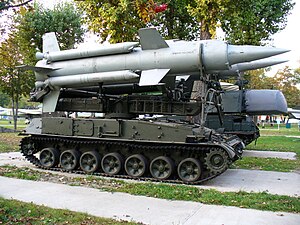SA-4
| 2K11 Krug NATO reporting name: SA-4 "Ganef" |
|
|---|---|

2K11 TEL in transit
|
|
| Type | Transportable SAM system |
| Place of origin | Soviet Union |
| Service history | |
| In service | 1965-present 1965- 1990s (USSR) |
| Used by | See list of operators |
| Production history | |
| Designer | Lyulev Novator |
| Designed | 1957 |
| Manufacturer | MZiK |
| Variants | Krug, Krug-A, Krug-M, Krug-M1, Krug-M2, Krug-M3 |
| Specifications (2K11 Krug) | |
| Weight | 28,200 kg |
| Length | 7.5 m (9.46 m with missiles) |
| Width | 3.2 m |
| Height | 4.472 m (with missiles) |
| Crew | 3 to 5 |
|
|
|
| Armour | 15 mm |
| Engine | V59 V-12 water-cooled diesel 520 hp |
| Power/weight | 17.33 hp/t |
| Ground clearance | 0.44 m |
| Fuel capacity | 850 litres |
|
Operational
range |
780 km |
| Speed | 35 km/h |
| 9M8 | |
|---|---|

TEL at Ukrainian Air Force Museum in Vinnitsa.
|
|
| Type | Surface-to-air missile |
| Place of origin | Soviet Union |
| Production history | |
| Variants | 3M8 (later 9M8) Krug, 9M8M Krug-M, 9M8M1 Krug-M1, 9M8M2 Krug-M2, 9M8M3 Krug-M3. |
| Specifications (9M331) | |
| Weight | 2,453 kg |
| Length | 8.784 m |
| Diameter | 86 cm |
| Warhead | Frag-HE |
| Warhead weight | 150 kg |
|
Detonation
mechanism |
contact and proximity fuzes |
|
|
|
| Propellant | kerosene fuelled ramjet |
|
Operational
range |
55 kilometres (34 mi) |
| Flight altitude | 24,500 metres (80,400 ft) |
| Boost time | four solid fuel booster rocket motors |
| Speed | Mach 4 |
|
Guidance
system |
Radio command |
The 2K11 Krug (Russian: 2К11 «Круг»; English: circle) is a Soviet and now Russian medium-range, medium-to-high altitude surface-to-air missile (SAM) system. The system was designed by NPO Novator and produced by Kalinin Machine Building Plant. Its GRAU designation is "2K11." Its NATO reporting name is SA-4 , after a word of Yiddish origin meaning "thief" or "rascal."
Development of the Krug ZRK-SD (2K11) air defense system started in 1957 by the Lyulev OKB design bureau. It was first displayed during a parade in Moscow in May 1965. The system started to be fielded in 1967 and became fully operational in 1969. It was used by the Russian Army as a long-range SAM.
The early version of the Krug entered service in 1965. The first operational deployment version, the Krug-A, entered service in 1967, with extensively modified versions, the Krug-M in 1971 and the Krug-M1 in 1974, which were developed to rectify problems discovered during army service. The upgraded version Krug-M was fielded in 1971 and the Krug-M1 in 1974. A target drone called 9M316M Virazh, developed from obsolete Krug missiles, was proposed for export in 1994.
The 2K11 was briefly operated by the Soviet army during the war in Afghanistan in 1979 and 1980, but was withdrawn several months after the initial invasion. In 1997, it was reported that, between 1993 and 1996, some 27 fire units of Krug and 349 missiles had been sold to Armenia. Poland flight tested four missiles in September 2006 against P-15 Termit (SS-N-2 'Styx') targets.
The TEL vehicles are tracked based on a GM-123 chassis and carry two missiles each on an elevating turntable for up to 360-degree rotation and 70-degree elevation. The two primary versions of the missile in service are the 9M8M1 (former designation 3M8M1) (2K11M "Krug-M") and 9M8M2 (former designation 3M8M2) (2K11M2/3 "Krug-M1"), both of which are believed to be known to the US DoD as SA-4B. The original 9M8 (former designation 3M8) (SA-4A) was first introduced into service in 1965 and followed by the upgraded 9M8M (2K11A "Krug-A") in 1967 before the 9M8M1 in 1971 and the 9M8M2 in 1973. The 9M8M2 actually has a lower maximum engagement altitude and shorter range in exchange for better performance in engaging aircraft close to the battery. Each battery typically consists of two 9M8M1 missiles and four 9M8M2 missiles as well as the following radars:
...
Wikipedia
